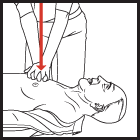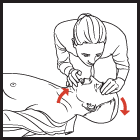Who Knows What Evil Lurks in the Heart of Men?
"Is it bad, is it egoistic when people who have been placed in certain positions try to do something that is beneficial for them, even when they know that by doing so they end up harming someone else?"
"[No one] could have been better than he [Joseph Goebbels] at transforming from a civilized, serious person into that ranting and raving hooligan."
"I just didn't listen [to Goebbels's 'total war' declaration of 1943]. Because it didn't interest me. That was a stupidity within me, I know this now."
"No, I wouldn't see myself as being guilty. Unless you end up blaming the entire German population for ultimately enabling that government to take control. That was all of us. Including me."
"The people who today say they would have done more for those poor, persecuted Jews, I really believe that they sincerely mean it. But they wouldn't have done it, either. By then, the whole country was under some kind of a dome. We ourselves were all inside a huge concentration camp."
Brunhilde Pomsel, shorthand writer, Nazi propaganda minister Joseph Goebbels

Having reached the ripe old age of 105, Ms. Pomsel has had a long time to muse upon her enabling role as a cipher in the machinery of Nazi Germany; more than that, she aided and abetted the process of diminishing Europe's Jews from human beings to disposable scum. In introspection she feels she did no more and no less than anyone else in her place might have done. Thinking of her need to be employed, to be comfortable and accepted, knowing that there was a cost in what she pursued and it was a cost borne by millions of persecuted, ultimately exterminated Jews.
She is considered to be the last witness of the processes by which the Nazi regime focused on its goal of genocidal intent, the mass extermination of a despised 'race' to whom all the ills of the world were attributed. This institutionalized, bitter racism took second place to nothing; given equal treatment to the equally vital work of leading the Axis powers to eventual victory over the Allies. Nazi Germany succeeded to a surprising degree in its annihilation of Europe's Jews, but the victory of conquest on the world stage eluded it.
Ms. Pomsel was born in 1911 Berlin, and for a while she was a stenographer working for a Jewish lawyer, then went on in her early 20s to work as a typist for a right-wing nationalist. Soon afterward connections helped her land a position in the broadcasting station of the Third Reich from which, nine years later, she transferred to the Ministry of Public Enlightenment and Propaganda where she worked under Goebbels. Goebbels, she recalled, was the mastermind, "an outstanding actor", the mastermind of denigration and hatred.
She had never, she insists, had any inkling of the plan to exterminate Jews en masse for she was not privy to that information. Her eyes and ears were busy elsewhere. Knowing nothing about Nazi war crimes let alone mass killings she was simply a hard-working woman hoping to achieve some measure of success in her working life. She remains a still-living participant in a historical event of immense significance representing the capacity of ordinary people to live in an era of bloody murder on a vast industrialized scale, but seeing nothing, hearing nothing, knowing nothing.
 Title: Insatiable
Title: InsatiableThe lead article is on the Moscow show trials. The cartoon caption: “Far be it from the Jews to enslave a single people. Their goal is to devour the entire world.”
October 1936 (Issue #41)
Accepting whatever their government instituted, willing themselves to believe that Germany was fighting a just war against nations seeking to destroy it; living their lives with no curiosity whatever related to business that didn't touch them personally because they would not let it and to remain untouched one must know nothing. So that later, in self defence the 'nicht schuldig' response could exonerate one from any and all responsibility, even though their acceptance of what they felt they could not change meant that they were enablers of evil.
A film produced by four directors is the venue and vehicle in which Ms. Pomsel describes her experiences and her thoughts. "A German Life" premiered in June in Germany, full of archival material, quotes from the propaganda minister, and interviews with Ms. Pomsel. Its purpose, meant to remind the world of the barbarity that proceeded with utter impunity to rid the world of a pestilence masquerading as an ethnic, cultural, religious, historical group of people who refused to go gently into that dark night but succumbed nonetheless.
"The dangers are still alive. It could happen again."
"One of the main aims of the film is to have the audience question: How would I have reacted? What would I have done in her situation for a new step in my career?"
Olaf Muller, film director
 May, 1934 Issue of Der Stürmer
May, 1934 Issue of Der StürmerLabels: Holocaust, Nazi Germany







 Photo: Shuler family
Photo: Shuler family 















